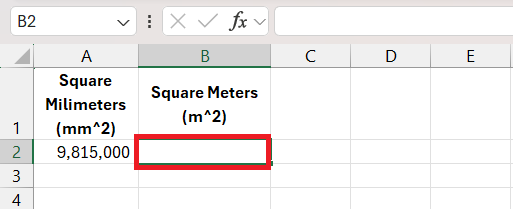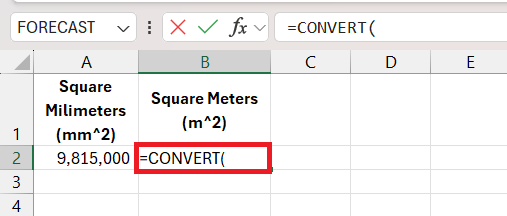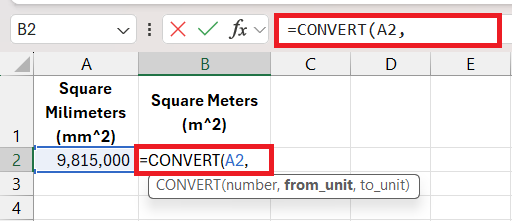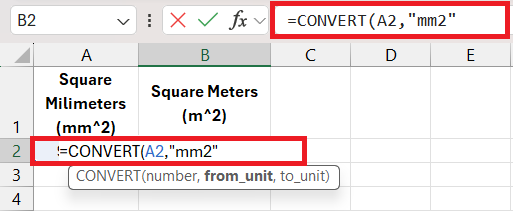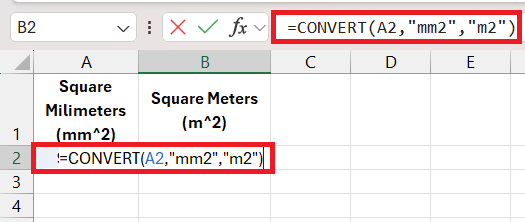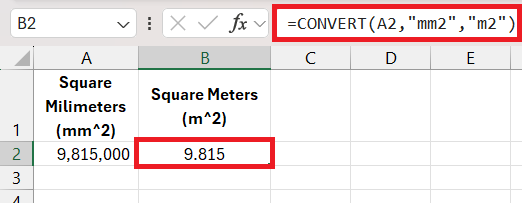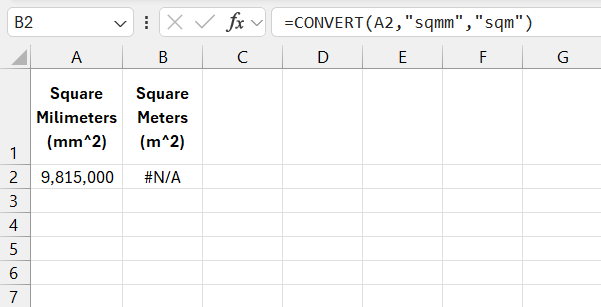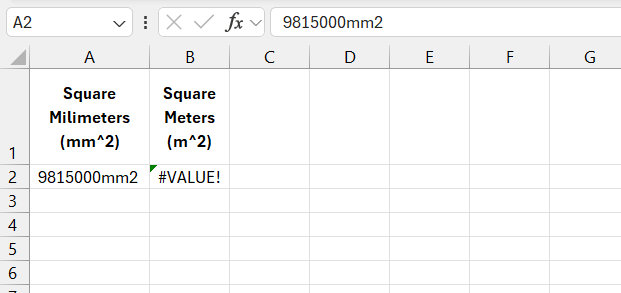

Unit conversion is essential in various fields, aiding in standardizing measurements and ensuring clear communication. Microsoft Excel‘s CONVERT function streamlines this process, allowing for quick and accurate conversions between different units, like mm to square meters, enhancing productivity and reducing errors.
5 Key Takeaways
- Excel’s CONVERT function simplifies converting units, such as square mm to square m, saving time and minimizing errors.
- Understand the CONVERT function syntax: =CONVERT(number, “from_unit”, “to_unit”) for flawless conversions.
- Common errors like #N/A or #VALUE! often stem from incorrect syntax or unit abbreviations; double-check these elements.
- Maintain conversion accuracy by validating input data, using correct units, and cross-verifying results.
Table of Contents
Introduction to Unit Conversion in Excel
The Significance of Converting Units
Unit conversion is fundamental across various fields, whether you’re a scientist, engineer, student, or working in finance. It helps in standardizing measurements, facilitating clear communication, and ensuring consistent data comparisons. Leveraging a tool like Excel to effortlessly switch between units can save time and reduce human error, enhancing productivity and accuracy.
Overview of Excel’s Convert Function
Excel’s CONVERT function is a powerhouse for transforming measurements from one unit to another with ease. Whether you need to convert pounds to kilograms or square feet to square meters, this native Excel feature is your go-to tool. It simplifies complex conversions by doing the heavy lifting for you, eliminating the need for manual conversion tables or complicated calculations.
Understanding the Basics
What is a Square Millimeter (mm2)?
A square millimeter, abbreviated as mm^2, is a tiny area unit in the Metric System. Imagine a square that’s as wide as a standard pencil’s thickness – that’s about one millimeter on each side. Now, picture that in a perfect square, and you’ve got an area that totals one square millimeter. It’s especially useful in smaller-scale applications, like designing microchips or mapping out detailed architectural pieces.
What is a Square Meter (m2)?
A square meter, denoted as m^2, is the SI derived unit for area used in the metric system. It represents the size of a square with each side measuring precisely one meter in length. Square meters are commonly applied in real estate to express the area of a space, like a room or plot of land, and in construction for materials pricing. Think about a space slightly larger than a standard-sized doorway—this gives you an approximate visualization of a square meter.
Using Excel’s CONVERT Function for sqaure mm to square m
Syntax and Parameters Involved
When using the CONVERT function in Excel, understanding its syntax and parameters is vital. The syntax for the CONVERT function is:
- number – This is the numerical value you wish to convert.
- from_unit – A text string denoting the unit you are converting from.
- to_unit – The unit you want to convert the number to.
Excel houses a list of predefined unit strings that you can use for both the “from_unit” and the “to_unit”. For converting square millimeters to square meters, you’ll use “mm2” for the “from_unit” and “m2” for the “to_unit”.
Remember, unit names and prefixes in Excel’s CONVERT function are, importantly, case-sensitive, so every letter must be correct for it to work.
Step-by-Step Guide on Conversion Process
To successfully convert square millimeters (mm^2) to square meters (m^2) in Excel, follow these straightforward steps:
STEP 1: Select a Cell: Click on the cell where you want your converted value to appear.
STEP 2: Input the Formula: Type in =CONVERT( to initiate the function.
STEP 3: Enter the Number: Input the numerical value you are converting, or reference the cell that contains it.
STEP 4: Define “from_unit”: After the number, type in ,"mm2", to set the original measurement unit.
STEP 5: Define “to_unit”: Finally, type in ,"m2") to indicate the desired unit.
STEP 6: Execute the Conversion: Press Enter to perform the conversion.
The completed formula will look something like this:
Tip: Replace A2 with the cell that contains the value you want to convert.
And there you go, the value in square meters will now display in the cell where you’ve entered the formula.
Practical Examples and Applications
Case Study: Converting Floor Plans from mm2 to m2
In the world of architecture and construction, having accurate measurements is non-negotiable. A recent case study revealed the efficiency gains when an architectural firm began using Excel to convert floor plan measurements from mm^2 to m^2.
The shift to digital conversion streamlined their workflow, reducing manual calculation errors and saving valuable time previously spent on recalculations and revisions. It provided a simple yet effective solution that ensured all contractors and stakeholders were working with consistent unit measurements.
This case accentuates not just the importance of precision in design and building but also showcases how Excel’s CONVERT function can be an essential tool in achieving that precision.
Analyzing Data Across Different Measurements and Scales
When dealing with diverse datasets, Excel’s CONVERT function becomes invaluable. For instance, if you’re analyzing energy consumption data from various countries, you might encounter figures in square millimeters, square meters, or even square feet.
With Excel, you can standardize these units to compare and create a coherent analysis. This harmonization enables clearer insights into patterns, trends, and outliers across datasets, which would be otherwise obscured by incompatible measurement scales.
This approach not only enhances data integrity but also simplifies communications with stakeholders who may not be as conversant with multiple measurement systems. Overall, Excel’s power to streamline unit conversion empowers you to focus more on the analysis rather than the preparation of data.
Potential Pitfalls and Common Errors
Troubleshooting Formula Mistakes
Encountering errors while using the CONVERT function? Don’t worry; they usually stem from simple mistakes that can be easily rectified. Here are a few pointers:
- Check the Syntax: Ensure that your formula sticks to the correct structure and that commas and quotation marks are in place.
- Verify Unit Abbreviations: Incorrect or unrecognized units often lead to the #N/A error. Double-check that you’re using the correct abbreviated unit codes and that they’re compatible for conversion.
- Ensure Numeric Values: Supplying non-numeric values as the “number” argument will prompt a #VALUE! error. Confirm that you’re referencing a cell with a numeric value or inputting a number directly into the formula.
By methodically reviewing these factors, most formula mistakes can be effectively corrected, leading to accurate conversion outcomes.
Ensuring Accuracy in Your Results
Ensuring accuracy is crucial when performing unit conversions in Excel. Inaccuracy can lead to significant miscalculations, affecting outcomes and decisions. To maintain accuracy:
- Source Data Validation: Always start with checking the integrity of your input numbers. Garbage in, garbage out, as they say.
- Recheck Units: Units must match the expected format. Double-check Excel’s documentation for the correct abbreviations and pay attention to case sensitivity.
- Cross-Verify: Use an independent method to validate at least a few results. This could be a manual calculation or an online conversion tool.
- Limit Rounding: Apply rounding, if necessary, only after all calculations are done to avoid cumulative rounding errors.
- Audit Formulas: Excel’s ‘Trace Precedents’ and ‘Trace Dependents’ tools are beneficial to ensure the right cells are being referenced.
With diligence and these measures, you can significantly improve the reliability of your conversion results.
Frequently Asked Questions (FAQ)
How do I fix #N/A errors in conversion formulas?
To fix #N/A errors in conversion formulas, ensure that the unit codes are correct and compatible for conversion. Check Excel’s documentation for valid unit abbreviations and confirm that they belong to the same measurement category (i.e., area, length, weight). Also, confirm that no binary prefixes are being incorrectly applied to units that do not support them.
Can I convert multiple units at once using the CONVERT function?
No, Excel’s CONVERT function is designed to handle one pair of units at a time per cell. To convert multiple units, you’ll need to apply the function separately for each conversion or use additional formulas or scripts to automate the process across multiple cells or datasets.
Is there a limit to the size of units Excel can convert?
Excel doesn’t impose a specific limit on the size of the units you can convert, but it is subject to the general constraints of numerical representation in the program. This includes a maximum of 15 significant digits of precision. As long as your numbers are within Excel’s handling capacity, the CONVERT function can process them without issue.
How do I convert mm to m in Excel?
To convert millimeters to meters in Excel, use the CONVERT function as follows:
- Click into the cell where you want the result.
- Input the formula
=CONVERT(A1, "mm", "m"), replacing A1 with the reference to the cell containing your millimeter value. - Press Enter, and you’ll see the value in meters.
How do I calculate m2 in Excel?
To calculate square meters (m^2) in Excel, you can convert from another unit of area such as mm^2 using the CONVERT function:
Alternatively, if you’re starting with linear meters, simply calculate the area by squaring the length in meters using the exponentiation operator ^:
Ensure A2 contains the side length in meters for a square area or both side lengths multiplied if the area is rectangular.
Can Excel do unit conversions?
Yes, Excel can perform unit conversions through its built-in CONVERT function. It can handle a variety of units across different measurement systems, including length, weight, temperature, and more, making it a versatile tool for diverse conversion needs.


John Michaloudis is a former accountant and finance analyst at General Electric, a Microsoft MVP since 2020, an Amazon #1 bestselling author of 4 Microsoft Excel books and teacher of Microsoft Excel & Office over at his flagship MyExcelOnline Academy Online Course.


